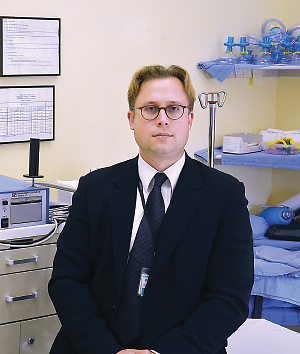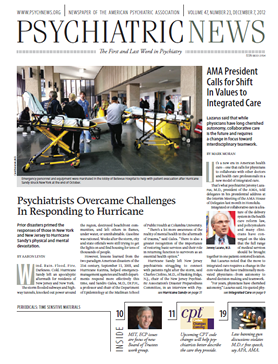Even though electroconvulsive therapy (ECT) is considered the treatment of choice for individuals with depression resistant to multiple trials of antidepressant medications or depressive episodes with psychotic features, catatonia, and severe suicidality, its use in American general hospitals seems to be waning.
This finding comes from a study published online October 10 in Biological Psychiatry. The lead researcher was Brady Case, M.D., an assistant professor of psychiatry at Brown University and director of the Health Services Research Program at Bradley Hospital in East Providence, R.I.
The study conducted by Case and his colleagues appears to be the first study on the use of inpatient ECT in U.S. general hospitals since 1992. They examined trends in the use of ECT in a national hospital sample over a 17-year period from 1993 to 2009. The hospitals were nonfederal, short-term general or specialty hospitals, including both public and private facilities and academic medical centers. However, freestanding psychiatric hospitals were excluded. In their paper, Case and his coworkers referred to all of the analyzed hospitals as “general hospitals.”
Here are several of their most salient findings:
•.
The percentage of general hospitals conducting ECT decreased from 15 percent to 11 percent, and the percentage of hospitals with psychiatric units conducting ECT decreased from 55 percent to 35 percent.
•.
The number of stays in general hospitals involving ECT rose from 1993 to 1995 from 13/100,000 residents to 16/100,000 residents, but then fell gradually after that, to 7/100,000 residents in 2009. This decline appeared to be due, to a large extent, to reduced use of ECT with elderly patients, a group traditionally thought to benefit most from it.
•.
For inpatients with severe recurrent depression, the percentage whose treating hospitals conducted ECT fell from 71 percent to 45 percent.
•.
Throughout the study period, depressed inpatients from poor neighborhoods and those who were publicly insured or uninsured were less likely to receive care from hospitals conducting ECT.
“The data strongly support the impression that psychiatric units of general hospitals are ceasing to conduct ECT and that this is driving the decline in the number of patients receiving ECT,” Case told Psychiatric News. But why are hospitals dropping the procedure?
Cost Pressures May Be to Blame
Possible explanations, Case said, are “growing pressures to avoid the inpatient treatment costs and length of stay associated with ECT and declining familiarity and more negative attitudes toward the procedure among providers and patients…. We didn’t have information on provider and patient attitudes, but as more facilities cease conducting ECT, we can expect that fewer clinicians and inpatients will be exposed to the option…. On the other hand, it is clear that popular perceptions of mental illness are increasingly biological, and where ECT is conducted, there has been no decline in patients electing to receive it.”
Case and his colleagues also noted, “We could not assess whether vagus nerve stimulation or transcranial magnetic stimulation—two somatic therapies for depression—might have delayed or replaced ECT in some patients after Food and Drug Administration (FDA) approval in 2006 and 2008, respectively.”
The findings have widespread implications, Case believes. For example, “most Americans admitted to general hospitals for severe, recurrent depression are now being treated in facilities that do not conduct ECT. This is the consequence of a solid 15-year trend in which psychiatric units appear to be discontinuing use of the procedure…. If the trends of the last 15 years hold, the number and proportion of general hospital psychiatric units conducting ECT will continue to decline, and fewer people will receive it.”
He added that regulations expected to be issued by the FDA will influence how ECT is used in the future, “but as far as I know, the decision about how to classify ECT devices is still pending. If the FDA follows its panel recommendation and ultimately retains Class III—high risk—status for ECT devices, then I would expect the decline to accelerate.”
Portrait of ECT Use Isn’t Complete
“This is an important and well-conducted study,” Charles Kellner, M.D., a professor of psychiatry at Mount Sinai School of Medicine and director of the ECT service at Mount Sinai Medical Center, said in an interview. “A main finding is the unfortunate unavailability of ECT to uninsured patients or under-insured patients [particularly in smaller nonacademic facilities].”
However, the results “do not give a complete picture of ECT use in the United States in 2012,” Kellner emphasized, “largely because freestanding psychiatric hospitals where ECT is conducted were not included in the study. Also, the study concerned only inpatient ECT, and most ECT experts believe that outpatient ECT is continuing to increase in volume in the United States. Furthermore, ECT training courses are well subscribed, and it is clear that younger psychiatrists are interested in learning about ECT. Both clinical and basic ECT research continues to be active. Despite the troubling decline, it should be kept in mind that the Case study shows that inpatient ECT is still practiced at more than 500 hospitals. It is likewise important to put the study into an international perspective. ECT remains a vibrant treatment throughout the world and is practiced in most countries.”
The research was financed in part by the Leon Levy Foundation.


